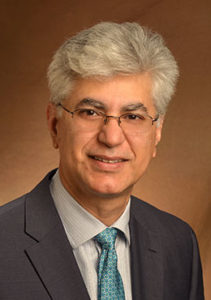While a disruptive technology might sound like a bad thing, it actually just refers to something that alters the operation of a market or an industry. The emergence of the smartphone is perhaps the most obvious example of a modern technology that created a huge disruption in society.
In transportation, electric bikes and scooters have begun to disrupt people’s reliance on cars for commuting. Widespread adoption of electric cars stands to disrupt society’s reliance of fossil fuels for transportation. If society can overcome some key challenges, connected and automated vehicles (CAVs) are anticipated to create an enormous disruption in transportation systems.

Asad Khattak
CEE Professor Asad Khattak is researching the path to a driverless future, and his findings show that the road to a fully automated CAV future is not smooth and certain. In a talk at the Howard H. Baker Jr. Center for Public Policy at UT entitled “The Bumpy Road to Driverless Cars,” Khattak outlined some of the questions he is asking in his quest to understand a path for widespread CAV adoption.
These questions include:
- How can driverless cars change the future of transportation?
- What is the potential impact of automation on our system?
- What are the promises, challenges, and the policy issues associated with these changes, and how can it all come together?
CAVs range in automation and are categorized on a scale from Levels 0–5. Levels 0–2 CAVs have driver support systems and an active and engaged driver is required, while levels 3–5 refer to driving systems that take complete control of the driving without human supervision.
There are currently no cars sold in the US that have levels of automation higher than 2.
Automation that is currently available offers drivers a chance to pay for added safety features, but higher levels of CAVs still remain in conceptual and testing phases.
While experts suggest that fully automated CAVs could potentially save almost 40,000 lives and 2.5 million injuries per year in the US alone, Khattak notes that there would need to be major changes to our legacy transportation system—roads, highways, and bridges—to allow for big investments and wide scale adoption of CAVs.
Khattak says that human factors are a big contributing cause of accidents, and about 90 percent of the current crashes have some kind of human error or violation. Further, the mobility benefits would include increasing the route capacity to reduce congestion and reducing vehicle operating costs of driving. Finally, they could enhance equity by providing mobility to elderly and people with disabilities.
“The transportation system of the future would certainly be smarter and resilient than we have today, and it’s anticipated to integrate automation,” said Khattak. “The big question is ‘How do we integrate this vehicle automation and connectivity of vehicles in legacy transportation systems?’”
Cars made today have more sensors that are generating a lot of big data, for which we need new techniques compared to the conventional statistical techniques. He says that the emergence of artificial intelligence and deep learning in the field will help with better predictions of travel behavior and adds that cities can take the lead in delving into these new opportunities to be more accessible and offer enhanced safety, mobility, and energy efficiency.
In many ways the future of infrastructure that supports CAVs will be at the city level, where planning can lead to social benefits like smaller footprint for roadways, more green space and greener infrastructure.
“Transformational changes can have unintended consequences,” he said. “We need to be very careful as to how we go about planning for them. Some say the benefits that can be captured will be in terms of integrating AVs with existing public transit. I would take it a step further to say they even need to be integrated with the current fleet of vehicles and also the multi-modal system, which includes pedestrians, bicycles, and motorcycles.”
Ultimately, Khattak says the uncertain future will require a vision for pathways to success and better capital planning.
